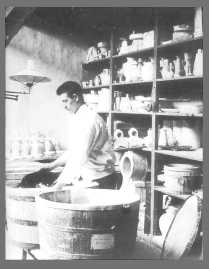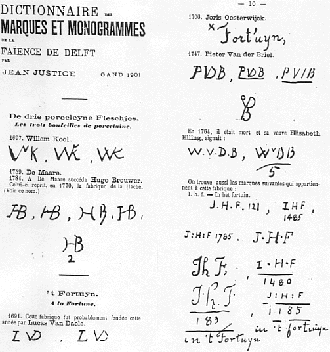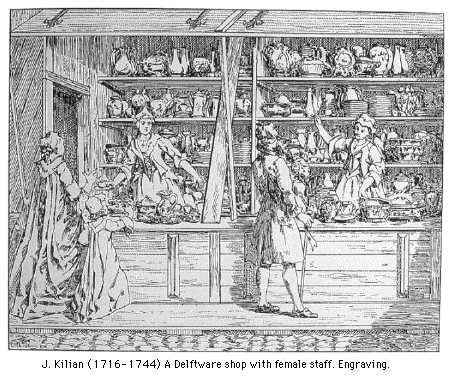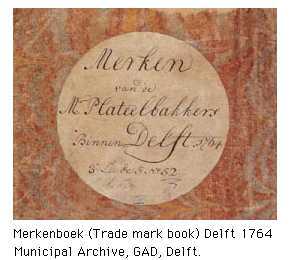 De
Porseleyne Fles
De
Porseleyne Fles De
Porseleyne Fles
De
Porseleyne Fles23. De Porceleyne Fles - The Porcelain Bottle / Les trois bouteilles de porcelain (workshop active from 1653 - to the present day). Initially situated at Oosteinde 171, west side between Broerhuisstraat and Jan Molslaan. The workshop kept expanding and occupied a number of houses which incuded (going south-east towards Molslaan) the houses named De Ram, Vergulde Leeuw, Porceleyne Fles and Gulde Cloot, nrs 169 - almost to 177. Just across the water, was another set of two building at nr 208 called Het Hoge Huis.
In 2002 the Porseleyne Fles is situated just outside the center of Delft towards the south at Rotterdamseweg 196, (P.O. Box 11, 2600 AA Delft) tel. +15 - 251 20 30. See their internet site http://www.royaldelft.com
A wonderful 174 page publication by Hoekstra-Klein focuses on this workshop.
Plans are being developed to combine this commercial Delft Blue factory with the outstanding public Delft Blue collections of various Delft Municipal Museums. This combined center will be housed later on in The Armamentarium building (Now Legermuseum / Army Museum).
 The
workshop was initially housed in trhe former Friar Minor
(Minderbroeders or Broerhuis) convent was situated at the
large area between 1) south side of the Broerhuis straat 2) Oosteinde
3) Molslaan. A major part of the buiklding was demolished after 1595.
The refectory section of this building at Oosteinde, west side
between Broerhuisstraat and Jan Molslaan was the first workshop
location of the Porceleyne Fles.
The
workshop was initially housed in trhe former Friar Minor
(Minderbroeders or Broerhuis) convent was situated at the
large area between 1) south side of the Broerhuis straat 2) Oosteinde
3) Molslaan. A major part of the buiklding was demolished after 1595.
The refectory section of this building at Oosteinde, west side
between Broerhuisstraat and Jan Molslaan was the first workshop
location of the Porceleyne Fles.
'Names of houses' file mentions it in 1703 and 1804. Compare above, on this list number 4. Details on the convent in H.C. Brouwer, 'Stedebouwkundige veranderingen...' in exh.cat. De Stad Delft, cultuur en maatschappij van 1572-1667, Vol I, p. 38. Museum Prinsenhof Delft, 1981.
Delftware Connoisseurship
A serious collector of Delftware will attempt to identify and date the object. On Delft blue plates and other Delftware objects such as jugs, a potters mark may give a first indication. One should always treat potters marks with caution. Marks must be considered as just one indication.
Masters & apprentices
All masters and apprentices working at this workshop had to be inscribed in the Delft St Luke Guild Book. In 1877 this book was published in a 120 page text by Obreen. In 2002 this text has been scanned and is now available and fully searcheable on this internet site. See the yellow field on top; first click the heading Delft Artists & Patrons and then click Obreen. The full text is in Dutch. Spelling varies; in order to find masters or apprentices of a faience workshop (plattielbackers, plateelbacker, platielbacker) search for the letters "plat".
 Translation
from theis entry in the Trade Mark book 1764: "The sign or trade mark
in the facade of the undersigned, is a porcelain bottle, which has
given the shop its name. Declare I the undersigned not to use any
other sign to mark, because of the Ordnances of Delft High
Leadership, on the goods which are produced here, to have drawn and
put the trade mark PD."
Translation
from theis entry in the Trade Mark book 1764: "The sign or trade mark
in the facade of the undersigned, is a porcelain bottle, which has
given the shop its name. Declare I the undersigned not to use any
other sign to mark, because of the Ordnances of Delft High
Leadership, on the goods which are produced here, to have drawn and
put the trade mark PD."
According to Jan Pluis this workshop made no Delft blue tiles. Delft potteries which did produce Delft blue tiles were these: Rouaan, later known as Het Lage Huys, De Lampetkan, De Vergulde Blompot, De Ham, De Dissel, De Paeuw / Paauw, De Roos, De Grieksche A.

 Full
presentation at http://www.xs4all.nl/~kalden
Email the author at kalden@xs4all.nl
Full
presentation at http://www.xs4all.nl/~kalden
Email the author at kalden@xs4all.nl
All questions about identifying, dating, valuing, buying and selling: please go to www.Aronson.nl.
Notes: Thanks to the Delft Archives Staff for their help and enthusiasm. See Wik Hoekstra-Klein, volume 6 in her series 'Geschiedenis van de Delftse Plateelbakkerijen', on "De Porceleyne Fles", co-produced with the 'Projectgroep Delfts Aardewerk', published by Stedelijk Museum Het Prinsenhof, Delft, 2001. A well researched two volume book on Delftware is Marion S. van Aken-Fehmers et al, Delfts Aardewerk, Geschiedenis van een nationaal product, published jointly by Waanders, Zwolle & Gemeentemuseum, Den Haag, 1999 (part 1) and 2001 (part 2).
Mark shown in Jean Justice, 'Dictionaire des marques et monogrammes de la faience de Delft', Gand/Gent 1901.
Jan Pluis, De Nederlandse Tegel, decors en benamingen 1570-1930, The Dutch Tile, Designs and Names 1570-1930, Published by: Nederlands Tegelmuseum / Vrienden van het Nederlands Tegelmuseum [Otterlo] / Primavera Pers, Leiden 1997.
How did they make Delft blue faience? text in English
Hoe maakte men Delfts blauw plateel? Tekst in het Nederlands.
Visit The Hague municipal Gemeentemuseum site on Delft Blue.
Latest address location information was added from W. Hoekstra-Klein, Geschiedenis van de Delftse Plateelbakkerijen, vols 1 - 11. Published by the Stedelijk Museum 'Het Prinsenhof' Delft.
This page launched January 2002. Last update 25 October 2016.